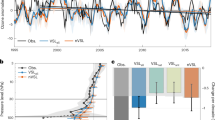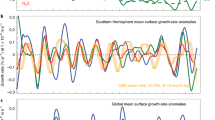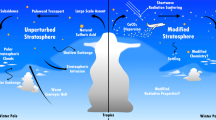Abstract
THE recent measurements1–3 of large values (8.1 ± 1.5 and (8.2 ± 2.7 × 10−12 cm3 s−1) of the rate coefficient for the reaction NO + HO2 → NO2 + OH (1) have led to some important revisions in our understanding of stratospheric photochemistry4. In particular, the predicted ozone perturbations due to the injection of nitrogen oxides by supersonic transport aircraft have become net ozone gains instead of losses5, while the predicted ozone depletion due to ozone-active chlorine from chlorofluoromethanes has almost doubled4. An unfavourable result of the adoption of the larger value of the rate coefficient for reaction (1) has been the prediction of excessive amounts of stratospheric ozone (10–20% more than the measured concentrations) both in terms of the total column abundance and the concentration profile at altitudes below 40 km. Attempts to remedy this discrepancy between theory and observation by altering the simulated lower stratosphere transport and by increasing the assumed amount of ozone-active chlorine were not successful. It is the purpose of this letter, however, to show that another recent measurement by Zahniser and Howard6 of the rate coefficient, k2, for the reaction HO2 + O3 → OH + 2O2 (2) largely resolves these problems of excessive stratospheric ozone in models. Zahniser and Howard have reported the first direct measurement of the reaction between HO2 and ozone (reaction 2). Their temperature-dependent rate coefficient is k2 = (1.4 ± 0.4) × 10−14 exp [−(580 ± 100)/T] cm3 s−1 which at stratospheric temperatures is 4 to 5 times larger than the value recommended in the report of the NASA Chlorofluoromethane (CFM) Workshop4, that is, 7.3 × 10−14 exp (−1,275/T) cm3 s−1.
This is a preview of subscription content, access via your institution
Access options
Subscribe to this journal
Receive 51 print issues and online access
$199.00 per year
only $3.90 per issue
Buy this article
- Purchase on Springer Link
- Instant access to full article PDF
Prices may be subject to local taxes which are calculated during checkout
Similar content being viewed by others
References
Howard, C. J. & Evenson, K. M. Geophys. Res. Lett. 4, 437 (1977).
Burrows, J. P., Cliff, D. K., Harris, G. W. & Thrush, B. A. Phil. Trans. R. Soc. (in the press).
Wilkinson, J. P. T. W.M.O. Symp. Toronto (1978).
Hudson, R. D. (ed.) NASA Ref. Publ. 1010 (1977).
Poppoff, I. G., Whitten, R. C., Turco, R. P. & Capone, L. A. NASA Ref. Publ. 1026 (1978).
Zahniser, M. S. & Howard, C. J. 4th Bienniel Rocky Mountain Regional Meeting, American Chemical Society, Boulder, Colorado (1978).
Simonaitis, R. & Heicklen, J. J. phys. Chem. 77, 1932 (1973).
DeMore, W. B. & Tschuikow-Roux, E. J. phys. Chem. 78, 1447 (1974).
Cox, R. A. IAGA/IAMAP Joint Assembly, Seattle, Washington (1977).
Hamilton, E. J., Naleway, C. A. & Ruey-Rong, L. Int. J. chem. Kin. 9, 87 (1977).
Borucki, W. J. et al. AIAA Jour. 14, 1738 (1976).
Whitten, R. C. et al. NASA Tech. Pap. 1003 (1977).
Wilcox, R. W., Nastrom, G. D. & Belmont, A. D. J. appl. Meteorol. 16, 290 (1977).
Heath, D. R., Mateer, C. L. & Krueger, A. J. PAGEOPH 106–108, 1238 (1973).
Author information
Authors and Affiliations
Rights and permissions
About this article
Cite this article
WHITTEN, R., BORUCKI, W., CAPONE, L. et al. Effect of the reaction HO2 + O3 → OH + 2O2 on stratospheric ozone. Nature 275, 523–524 (1978). https://doi.org/10.1038/275523a0
Received:
Accepted:
Issue Date:
DOI: https://doi.org/10.1038/275523a0
This article is cited by
-
Depletion of atmospheric ozone by nitrogen dioxide: a bifurcated reaction pathway
Theoretical Chemistry Accounts (2013)
Comments
By submitting a comment you agree to abide by our Terms and Community Guidelines. If you find something abusive or that does not comply with our terms or guidelines please flag it as inappropriate.



